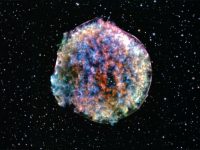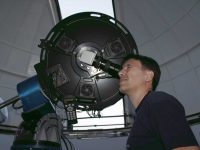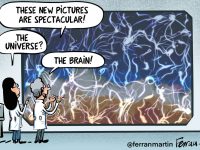Imagination and Science: an Inseparable Pair
Undetectable but essential entities for past and present astronomers
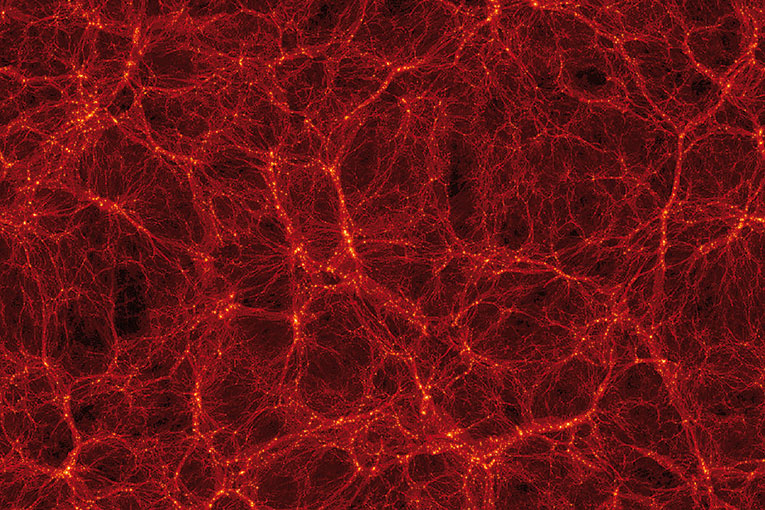
| «Be not the first by whom the new are tried, Nor yet the last to leave the old aside» Alexander Pope, Essay on Criticism Throughout the history of astronomy, various thinkers, philosophers and scientists have postulated the existence of entities which, not being visible or detectable in their time, or perhaps ever, were however necessary to maintain the stability of the cosmos, as they saw and understood it. They could be entities whose existence would explain, or at least justify, the astronomical observations of the time. We have identified some of them from ancient times to the present day. Here we explain them along with some examples from other sciences. In many cases, the passage of time showed that such postulates were wrong and the hypothesis or beliefs that supported them had to be abandoned. In other cases, the postulated entities were eventually discovered, and these discoveries constituted stellar moments of science. OLD MYTHS: WHY DOES THE SKY NOT FALL ON OUR HEADS? In almost all ancient mythologies the existence of something or someone who would be responsible for separating the skies from the Earth was postulated. For the Egyptians, Shu (the air) kept Nut (the sky) above Geb (the Earth). There are similar versions in the Babylonian or Chinese mythologies. In the latter, the god Pan-ku, aided by a turtle and some mythological animals (a phoenix, a dragon and a qilin), separates the land from the sky for several tens of thousands of kilometres. In Genesis there is no similar entity, having been the Creator himself who put every thing in its place – including the sky and the Earth – on the first attempt. In the Greek mythology that we have learned since childhood, which explains how the constellations emerge from the relations among the gods and between gods and humans, the role of Atlas, condemned by Zeus to hold up the pillars of the Heavens, is relevant in this context. |
«Modern cosmologists have been postulating the existence of dark matter for decades. It is essential to explain the stability of the clusters of galaxies or the rotation speeds of the stars in the spiral galaxies» |
|
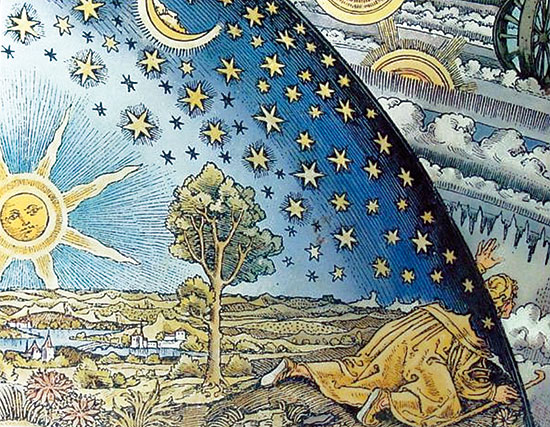 Mètode MètodeColour version of the engraving that appears in the work of Camille Flammarion L’ Atmosphère: Météorologie Populaire (Paris, 1888) which evokes humanity’s passion to unveil the mysteries of the cosmos. |
||
|
CRYSTAL SPHEREs Leaving myths behind and getting into more rational explanations, we will begin by remembering Eudoxus, who in the fourth century BC postulated the existence of spheres – transparent or crystalline – with the Earth as their centre to explain the apparent movements of the sun, the moon, the planets and the stars. Aristotle, Plato’s disciple and Alexander the Great’s teacher, presented a world system with concentric spheres, with the fixed stars in the last of them. The Heavens would be immutable and the stars that inhabit them would be made of quintessence, a new element that he needed to postulate to provide the supralunar region with a constitutive material different from the terrestrial four which, according to Empedocles, were the basis of everything observed: air, fire, water and earth. Greek cosmology had a spectacular development in the Hellenistic period by the hands of Aristarchus, Eratosthenes, Apollonius and Hipparchus, among others. A veritable scientific revolution – though forgotten – occurred in those centuries, as the Italian physicist Lucio Russo (born in 1944) claims. This cosmology reaches its final version with Ptolemy in the second century AD. He postulated the existence of geometrical entities that are essential to explain the observed movements of the celestial bodies – in particular the retrograde motion of the planets – in a geocentric world system: the planets moved on small spheres that received the name of epicycles, whose centres, in turn, revolved around a bigger sphere, called deferent. This could be centred on Earth or, eventually, on an eccentric point called equant, with respect to which the centre of the epicycle apparently moved circularly and uniformly. This system would last until the sixteenth century, in part because there was no alternative, but also because it was incorporated into the doctrine of the Catholic Church by Thomas Aquinas (1225-1274) in the thirteenth century. For instance, Georg Peurbach (1423-1461) considered that the Ptolemaic spheres were solid and therefore other bodies could not go through them. Their existence was not called into question with the new world conception postulated by Nicolaus Copernicus (1473-1543) either. According to him, the sun, and not the Earth, occupied the central position. Tycho Brahe (1546-1601) was the one who, when observing the comet of 1577, called into question the existence of such spheres as solid entities, since the comet, whose orbit he studied in detail, would go through them. |
«In the second century AD, Ptolemy postulated the existence of geometrical entities to explain the observed movements of the celestial bodies in a geocentric world system» |
|
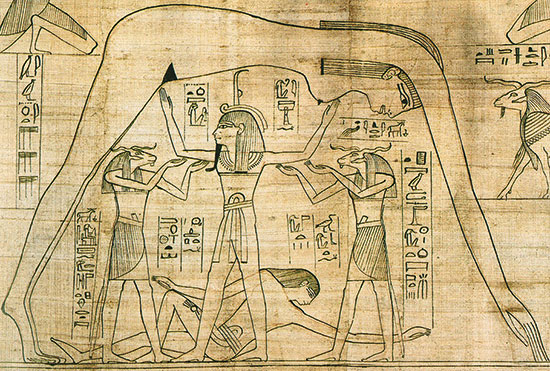 British Museum British MuseumThe Egyptian goddess Nut, in a representation in which she is seen holding up the starry celestial dome and thus protecting the Earth denizens. |
||
|
UNENLIGHTENED STARs In the face of a new astronomical observation that might, at the beginning, seem paradoxical, it is reasonable to postulate the existence of entities which, despite being initially undetectable, could convincingly explain the observations. When English amateur astronomers John Goodricke (1764-1786) and Edward Pigott (1735-1825) systematically studied the stars we now call variable, whose brightness changes periodically with the passage of time, they suggested that the brightness variations were a consequence of another dark star (unenlightened star) the crossing in front of it. It would be interesting to highlight that this argument was put forward when pairs of gravitationally linked stars forming binary systems were still unknown. Although certainly the variability of many of these stars is due to internal pulsations, as Sir Arthur S. Eddington (1882-1944) showed in 1926, the unenlightened stars that eclipse others stopped being mere hypothesis when, making use of spectroscopy, accurate measures of the radial velocity of stars were carried out and the existence of eclipsing binary stars was proved. NEWTON’S DEFENCE But without a doubt, the biggest set of entities postulated to defend a particular conception of cosmos occurred with Sir Isaac Newton’s (1643-1727) gravity. The most spectacular example was the discovery of Neptune in 1846. Years before, in 1781, Wilhelm Herschel (1728-1822) and his sister Caroline (1750-1848) had discovered the planet Uranus somewhat by chance. The anomalies observed in the orbit of Uranus let to postulating the existence of an eighth planer further away. Urbain Le Verrier (1811-1877), from the Paris Observatory, and, independently, Englishman John Couch Adams (1819-1892) determined where it should be found and that was where it was found, just a few weeks after Le Verrier announced his definitive prediction. That was only possible because Uranus had passed Neptune in its orbit around the Sun just a couple of years before. Had one and the other been found at opposite sides of the Sun, the observations would not have been exposed. Similarly, Friedrich W. Bessel (1784-1846) said that the movements of two of the brightest stars, Sirius and Procyon, meant that both should have a dark companion of a mass comparable to that of those stars. As Bessel died in 1846, he did not get to say «I told you so» when Alvan Clark (1804-1887) discovered Sirius B in 1862 and John M. Schaeberle (1853-1924) Procyon B in 1895. These successes were followed by many failures in the work of trying to detect what was initially predicted. By then an anomaly observed in Mercury’s orbit was known. Its perihelion (the point of the orbit closest to the Sun) experiences a secular advance (precession), which, although very small, could be observed with enough accuracy. The value that was measured was higher than the one calculated making use of the Newtonian theory. Today we know that the small difference can be naturally explained with Einstein’s theory of gravitation (general relativity), but to justify the excess, in the nineteenth century, different entities were proposed that were obviously never detected: a planet beyond Mercury’s orbit, which received the name Vulcan, an also intra-mercurial asteroid ring, a rather flattened Sun, the push of the ether, deviations from Newton’s law of gravity in the vicinity of the Sun, etc. |
||
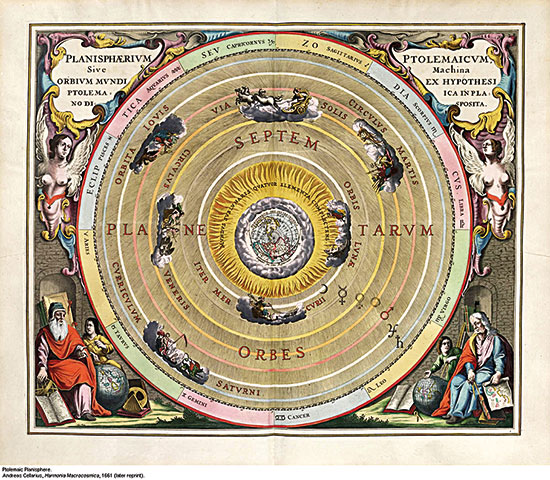 Special Collections, University of Amsterdam Special Collections, University of AmsterdamThe spheres of Ptolemy’s world system, in a representation appearing in Harmonia Macrocosmica, by Andreas Cellarius (1661). It shows the planets moving around the epicycles, whose centres in turn move around the deferent. |
«René Descartes proposed the existence of luminous, transparent and opaque matter. The Sun and the stars were made of the first; Earth and the planets, of the last. The one in the middle, ethereal, moved around forming the vortexes that pull the planets» |
|
|
THE DARK NIGHT SKY Another phenomenon that requires resorting to the invisible is Olbers’ paradox, which we can lay out with a question: why is the sky dark at night? The name is due to German astronomer Heinrich Olbers (1758-1840), who popularised it. The darkness of night is an observable fact, but, to give a convincing answer to that question, some scientists needed to postulate the existence of entities without whose contribution the answer did not seem so obvious. Many philosophers of nature, including Giordano Bruno (1548-1600), Thomas Digges (1546-1595) or Newton, believed that the universe had an infinite extension in space and time and that it was uniformly populated with stars on a large scale. These ideas had already emerged in ancient Greece with Democritus or Epicurus, while others, such as Zeno of Citium, proposed a finite cosmos of stars surrounded by an infinite vacuum. If the universe was finite and uniformly populated with stars, the night would be as bright as the day. Edmund Halley’s calculations thus proved it. In order to avoid this burning sky, both he and Digges argued that sufficiently distant objects provided too little light to «move our senses». Fritz Zwicky (1898-1974) pointed out a modern version of this idea in 1929 when he spoke of « tired light» to explain the shift to the red that is observed in remote galaxies. Today we know that this hypothesis is false. A second solution to Olbers’ paradox was proposed by Jean-Philip Loys de Cheseaux (1718-1751) and later on by Olbers himself and consisted in postulating that some kind of ether in space or the interstellar medium would absorb part of the light of the stars in their path to the Earth, in such a way that the night sky would continue to be dark. Today, we know that, for thermodynamic reasons, this hypothesis cannot be sustained. The absorption cannot hide a whole universe of stars, since the eventual absorbent material would heat up in such a way that it would radiate the absorbed light again. A third solution defended by John Herschel (1792-1871) and Richard A. Proctor (1837-1888) was based on abandoning the idea of the uniform distribution on a large scale and suggesting a hierarchy in the groupings of cosmic matter (stars come together to form galaxies, which in turn form clusters of galaxies, and so on); an idea that Immanuel Kant (1724-1804) had already advanced in 1755 and that in modern terminology is known as a fractal structure. If this hierarchy did not end, since the density of matter decreases when the scale grows, there would always be holes without stars in the sky, and the night would continue to be dark. In any case, the solution is not valid either, since, with the study of cosmic structure in a large scale, we have learned that the fractal regime is observed in the distribution of galaxies only at certain scales, and it disappears at larger scales, and therefore the fractal universe is an entity that lacks a foundation. Olbers’ enigma is resolved with only the consideration that the stars that populate the expanding universe do not live forever and that their light travels at a finite speed, so the light of all of them cannot – at any time in cosmic history – make the night sky shine. |
|
|
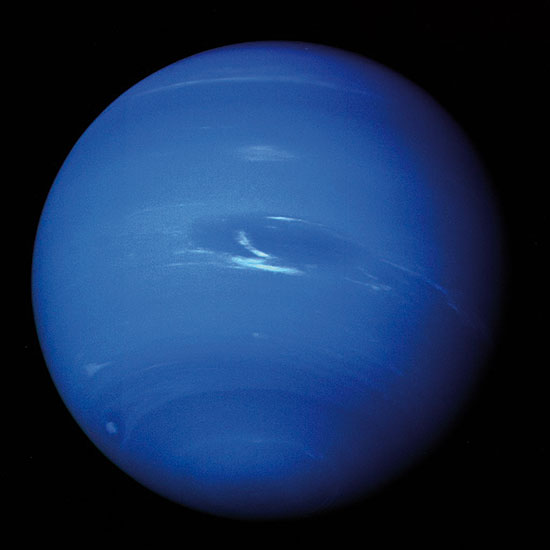 NASA NASANeptune, photographed by the Voyager 2 spacecraft in 1989, 143 years after the planet was discovered. |
||
|
LUMINESCENT ETHER The «ether» is without a doubt the «postulated but unseen entity» that has appeared the most throughout the history of science, from Aristotle to the present day. The fear of nothingness has led many scientists to rely on ether to avoid spaces with nothing inside. Certainly, the most elaborate cosmos based on ether comes from René Descartes (1596-1650), who proposed the existence of three types of matter – luminous, transparent and opaque. The Sun and the stars were made of the first; Earth and the planets, of the latter. The one in the middle, ethereal, moved around forming the vortexes that pull the planets. In some way these vortexes replaced the crystal spheres to which the planets where linked in the geocentric cosmologies. Christiaan Huygens (1629-1695), Gottfried Leibniz (1646-1726) and even Newton – in his beginnings – tried to explain the movements in the solar system by making use of Cartesian principles in which the universe was a plenum of ether. Newton would abandon these ideas later on, his universe would be practically empty and in it the gravitational forces would propagate at infinite speeds, while for the propagation of light he would continue to make use of a more evolved notion of ether, as well as for the explanation of the curvature in the tails of comets. The experiments of Thomas Young (1773-1829), which gave an undulatory nature to light, revived the notion of the «luminescent ether», as Agnes M. Clerke (1842-1907) would describe in 1902: «the ethereal vehicle of the propagation of light», in the same way that sound needs a medium – the air – to propagate. Years before, in 1887, Albert A. Michelson (1852-1931) and Edward W. Morley (1838-1923) carried out an experiment that proved the absence of ether and that gave cause for the subsequent development of the theory of special relativity by Albert Einstein (1879-1955). THE DARK SIDE OF THE UNIVERSE Modern cosmologists have been postulating the existence of dark matter for decades. It is essential to explain, within the framework of the theory of gravitation that we accept, the stability of the clusters of galaxies or the rotation speeds of the stars in spiral galaxies. This matter must interact very weakly with the rest and, of course, it does not emit light, but its gravitational effects are patent in galaxies and clusters of galaxies. Its existence is proposed, but it is proving very elusive and we are still completely ignorant of its nature. For many decades, cosmologists have tried to quantify the rate at which the cosmic expansion should be slowing down due to the gravitational attraction of all the matter that constitutes the universe. However, in 1998, two teams of astronomers, whose leaders have been awarded the Nobel Prize for Physics, presented some results that showed precisely the contrary: the expansion is accelerating. By analysing the light coming from two very remote supernovae, these teams concluded that the reduction observed in the light coming from these supernovae was due to the fact that they are actually further away, which implies an accelerated expansion. The existence of a dark energy (or quintessence) that would act as a repulsive gravity was postulated. The dark side of the universe – dark energy and dark matter – represents 95% of its composition. These entities are proposed in order to understand the current observations of our universe, as the ether was postulated in order to understand the propagation of light, the epicycles and deferents in order to understand the retrograde movement of the planets, or Neptune in order to understand the anomalies in the orbit of Uranus. Of these last examples, only Neptune was found; the other simply do not exist. |
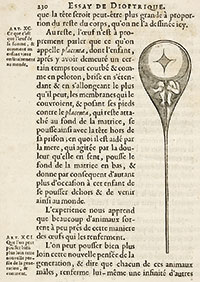 University of Cambridge University of CambridgeA few natural philosophers at the end of the seventeenth century claimed to have seen the homunculus in sperm, a sort of mannequin inside the spermatozoon, like this one that N. Hartsoeker represented graphically in 1694. |
|
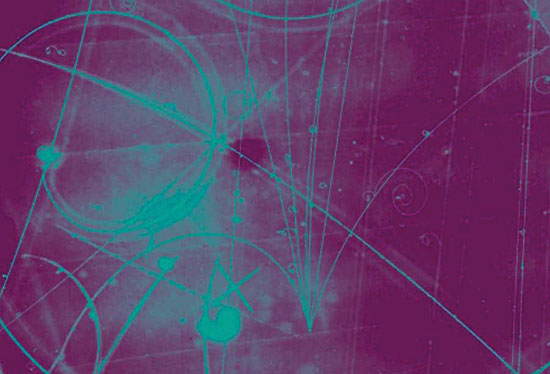 Booster Neutrino Experiment Booster Neutrino ExperimentPauli postulated the existence of neutrinos (particles without charge and practically without mass), which would be produced during the beta decay to compensate the supposed energy loss. Years later, Cowan and Reines proved their existence, as can be observed in this image, where traces of neutrinos in an experiment with particles of the Fermilab (Chicago) are shown. |
||
|
NOT JUST IN ASTRONOMY: THE HOMUNCULUS, THE PHLOGISTON AND THE NEUTRINO Similar entities have been postulated in other disciplines: the homunculus in physiology, the phlogiston in chemistry or the neutrino in physics. Theological preformationism doctrines, as well as the blame for the original sin, in addition to the relative lack of importance given to women, were still alive when the microscopes observed human cells for the first time. Therefore, it is not surprising that at least a few natural philosophers at the end of the seventeenth century claimed to have seen a sort of mannequin in sperm, a fully formed little man from which the foetus would later emerge: the homunculus, although Nikolaas Hartsoeker (1656-1725) and François de Plantade, also known as Dalempatius (1670-1741), differed on whether the spermatozoon’s tail was the head of the «little man» or not. The new microscopes and more open minds soon rejected this entity, although its reminiscences got to the times of Charles Darwin (1809-1882). In the time when fluids were used to explain any physical phenomenon and heat was a fluid called caloric, Georg E. Stahl (1659-1734) systematised an entity called phlogiston which flammable bodies would possess. Phlogiston would, therefore, be a fluid that would escape during combustion and, although its existence would certainly be ruled out, the attempts to measure its weight were crucial for chemists like Antoine-Laurent Lavoisier (1743-1794) to determine the role of oxygen in combustion. In 1930, Wolfgang E. Pauli postulated the existence of the neutrino to preserve the principle of conservation of energy in beta decay. Pauli postulated the existence of this particle without charge, practically without mass and maybe undetectable, which would be produced during the decay to compensate for the apparent energy loss. In 1956, Clyde L. Cowan (1919-1974) and Frederick Reines (1918-1998) proved its existence with an experiment (Reines was awarded the Nobel Prize in Physics in 1995). Other particles have lived stories of similar successes, such as the top quark, discovered at Fermilab (Chicago) in 1995, or the W and Z bosons, discovered at CERN (Geneva) in 1983. Perhaps in its new particle accelerator, the Large Hadron Collider, the story of the discovery of the longed for Higgs Boson (or the confirmation of its existence) is right now being written. EPILOGUE In general, the postulated entities that were never detected and that were eventually believed to be unnecessary or erroneous, because other explanations or discoveries made it necessary to set them aside, have been much more numerous. But without a doubt, in the few cases where what had been predicted was found, the success caused a great stir. If someday we come to know the nature of dark matter and energy, the discovery will deserve all the available awards – Nobel Prize included – but, at the present time, we cannot dismiss the possibility that these entities will wither with time, as many of their predecessors did in the past. |
||

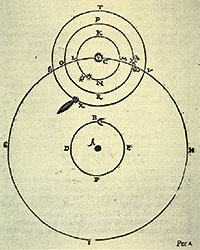 Mètode
Mètode